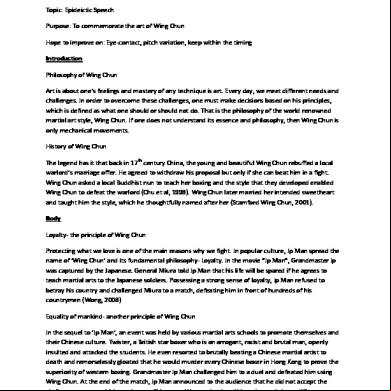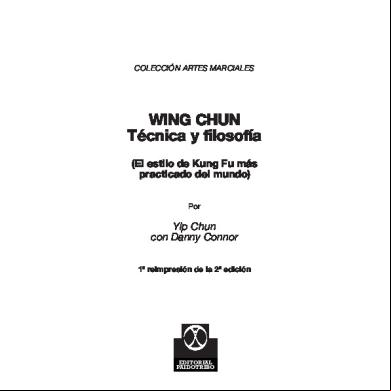Philosophy Of Wing Chun 5k2b12
This document was ed by and they confirmed that they have the permission to share it. If you are author or own the copyright of this book, please report to us by using this report form. Report 3b7i
Overview 3e4r5l
& View Philosophy Of Wing Chun as PDF for free.
More details w3441
- Words: 903
- Pages: 3
Title: The Art of Wing Chun Topic: Epideictic Speech Purpose: To commemorate the art of Wing Chun Hope to improve on: Eye-, pitch variation, keep within the timing Introduction Philosophy of Wing Chun Art is about one’s feelings and mastery of any technique is art. Every day, we meet different needs and challenges. In order to overcome these challenges, one must make decisions based on his principles, which is defined as what one should or should not do. That is the philosophy of the world renowned martial art style, Wing Chun. If one does not understand its essence and philosophy, then Wing Chun is only mechanical movements. History of Wing Chun The legend has it that back in 17th century China, the young and beautiful Wing Chun rebuffed a local warlord’s marriage offer. He agreed to withdraw his proposal but only if she can beat him in a fight. Wing Chun asked a local Buddhist nun to teach her boxing and the style that they developed enabled Wing Chun to defeat the warlord (Chu et al, 1998). Wing Chun later married her intended sweetheart and taught him the style, which he thoughtfully named after her (Stamford Wing Chun, 2001). Body Loyalty- the principle of Wing Chun Protecting what we love is one of the main reasons why we fight. In popular culture, Ip Man spread the name of ‘Wing Chun’ and its fundamental philosophy- Loyalty. In the movie “Ip Man”, Grandmaster Ip was captured by the Japanese. General Miura told Ip Man that his life will be spared if he agrees to teach martial arts to the Japanese soldiers. Possessing a strong sense of loyalty, Ip Man refused to betray his country and challenged Miura to a match, defeating him in front of hundreds of his countrymen (Wong, 2008) Equality of mankind- another principle of Wing Chun In the sequel to ‘Ip Man’, an event was held by various martial arts schools to promote themselves and their Chinese culture. Twister, a British star boxer who is an arrogant, racist and brutal man, openly insulted and attacked the students. He even resorted to brutally beating a Chinese martial artist to death and remorselessly gloated that he would murder every Chinese boxer in Hong Kong to prove the superiority of western boxing. Grandmaster Ip Man challenged him to a duel and defeated him using Wing Chun. At the end of the match, Ip Man announced to the audience that he did not accept the challenge to prove which was better: Chinese or Western boxing. Although people have different
standings in life, he doesn’t believe that one person’s integrity is worth more than the other and hopes that human beings can respect one another (Wong, 2010). The spread of Wing Chun Ip Man was the first to teach Wing Chun openly to the public (Wing Chun Kung Fu Academy, 2009). He made great contributions to Wing Chun by establishing the Wing Chun Athletic Association in Hong Kong and promoting it extensively (Ving Tsun Athletic Association Limited, 2005). The art of Wing Chun also became known world-wide through his students. One of whom is famous actor and martial arts practitioner Bruce Lee, who brought Wing Chun to U.S.A while living there. Following which, he made a huge impact through his acting career which led to the spread of Wing Chun worldwide via the media (Campbell, Sid, 2003). Applications Wing Chun teaches two important concepts- the control of emotion and the concept of centerline. The first concept teaches us that in any fight, one must always have a clear mind. If we do not keep our cool and attack wildly, we make things easy for a calm opponent who can defeat us effortlessly. In life, we face many difficulties daily. Much like in a fight, if we fail to stay calm, we will fail to make the right decisions. The second concept involves the use of science. By applying techniques of Mathematics and Physics, the practitioner of Wing Chun is able to land his blows in the shortest time possible. In today’s society, there is hardly a need for us to engage in a real fight. However, it is still useful to learn a technique or two for self-defense when we are faced with unforeseen circumstances.
Conclusion Wing Chun is not just another fighting style. It has a very rich history and encomes the spirit and beliefs of the Chinese. Wing Chun applies science and philosophy in its form of fighting and has many applications in our daily lives. Through Wing Chun, we learn the values of Chinese such as loyalty and equality amongst mankind. Wing Chun also teaches us to deal with problems with a calm state of mind so that we will be able to make wise decisions. Art encomes one’s feelings and the mastery of any technique is art and Wing Chun is definitely an extraordinary piece of art.
Bibliography Campbell, Sid. 2003. The Dragon and the Tiger: The Birth of Bruce Lee's Jeet Kune Do Chu, R., Ritchie, R., & Wu, Y. (1998): Complete Wing Chun: The definitive guide to Wing Chun's history and traditions. Boston, MA: Tuttle Publishing Stanford Wing Chun. (2001): History and principles of Wing Chun Kung Fu Ving Tsun Athletic Association Limited. 2005: Ip Man Ving Tsun 50th Anniversary Journal Wong. (2008): Ip Man (film) Wong. (2010): Ip Man 2 (film) Wing Chun Kung Fu Academy. 2009. Retrieved from http://www.wing-chun-kungfu.com/wing-chunhistory.htm
standings in life, he doesn’t believe that one person’s integrity is worth more than the other and hopes that human beings can respect one another (Wong, 2010). The spread of Wing Chun Ip Man was the first to teach Wing Chun openly to the public (Wing Chun Kung Fu Academy, 2009). He made great contributions to Wing Chun by establishing the Wing Chun Athletic Association in Hong Kong and promoting it extensively (Ving Tsun Athletic Association Limited, 2005). The art of Wing Chun also became known world-wide through his students. One of whom is famous actor and martial arts practitioner Bruce Lee, who brought Wing Chun to U.S.A while living there. Following which, he made a huge impact through his acting career which led to the spread of Wing Chun worldwide via the media (Campbell, Sid, 2003). Applications Wing Chun teaches two important concepts- the control of emotion and the concept of centerline. The first concept teaches us that in any fight, one must always have a clear mind. If we do not keep our cool and attack wildly, we make things easy for a calm opponent who can defeat us effortlessly. In life, we face many difficulties daily. Much like in a fight, if we fail to stay calm, we will fail to make the right decisions. The second concept involves the use of science. By applying techniques of Mathematics and Physics, the practitioner of Wing Chun is able to land his blows in the shortest time possible. In today’s society, there is hardly a need for us to engage in a real fight. However, it is still useful to learn a technique or two for self-defense when we are faced with unforeseen circumstances.
Conclusion Wing Chun is not just another fighting style. It has a very rich history and encomes the spirit and beliefs of the Chinese. Wing Chun applies science and philosophy in its form of fighting and has many applications in our daily lives. Through Wing Chun, we learn the values of Chinese such as loyalty and equality amongst mankind. Wing Chun also teaches us to deal with problems with a calm state of mind so that we will be able to make wise decisions. Art encomes one’s feelings and the mastery of any technique is art and Wing Chun is definitely an extraordinary piece of art.
Bibliography Campbell, Sid. 2003. The Dragon and the Tiger: The Birth of Bruce Lee's Jeet Kune Do Chu, R., Ritchie, R., & Wu, Y. (1998): Complete Wing Chun: The definitive guide to Wing Chun's history and traditions. Boston, MA: Tuttle Publishing Stanford Wing Chun. (2001): History and principles of Wing Chun Kung Fu Ving Tsun Athletic Association Limited. 2005: Ip Man Ving Tsun 50th Anniversary Journal Wong. (2008): Ip Man (film) Wong. (2010): Ip Man 2 (film) Wing Chun Kung Fu Academy. 2009. Retrieved from http://www.wing-chun-kungfu.com/wing-chunhistory.htm





